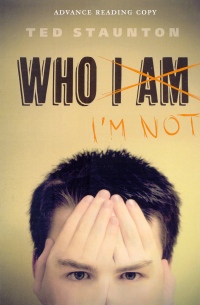| ________________
CM . . .
. Volume XX Number 4. . . .September 27, 2013
excerpt:
Danny (not his real name) has assumed the identity of a boy who disappeared over three years ago. After a series of abusive foster homes, referred to as the The Bad Time, Danny was taken in by Harley, a con man, and trained in the art of conning people. When Harley dies, Danny must run the ultimate con. He convinces both the authorities and the real Danny’s family that he is the missing teenager. As he gets caught up in a life based on a lie, he must face the fact that, although he knows he isn’t Danny, he also doesn’t know who he really is. As the officer who was in charge of missing person’s case becomes more and more suspicious of this unlikely return, he uses the new Danny to finally bring closure to the real Danny’s disappearance with tragic consequences. Based on a true story that Staunton explains in his author’s note, Who I’m Not explores the idea that hope often overrides evidence. As a reader, I found myself thinking that this was completely implausible. The character, himself, cannot believe that anyone will buy his scam. As I read, I struggled to decide whether this was the point. The characters seem to recognize the implausibility but choose to go along with it, which encourages the reader to do the same. That being said, there were still points where it got in the way of enjoying the story. The ease with which Danny crossed the border, the lack of DNA testing, and the seemingly limited support for the family is questionable. The desperation with which Danny’s sister, Shan, believes that this is her long lost brother is poignant. She seems to help him become Danny. Her motivation is both to have her brother back but also to prevent the further destruction of her family by accepting what really happened three years ago. Staunton explores identity from several perspectives. The first is Danny’s attempt to take over someone else’s identity. The other is to consider what it means to have no identity of your own. It is disconcerting to realize that the only name you have for the character is “Danny” even though that was who he was when the book begins. The main character has no idea who he is or his history. He has spent his life changing his identity to suit adults’ expectations. With the help of his new friend Gillian (who reminds him of The Great Gilly Hopkins), he realizes that he can begin to decide for himself who he will be. While Danny’s story seems implausible, it is somewhat offset by the strength with which he tells his own story. His description of The Bad Time, or his time in a series of abusive foster homes, is heart-wrenching. It is so easy to understand why he would do anything to avoid going back to that. Danny’s need to be someone, anyone, is uncomfortable to read as it makes one reflect on how identity is formed and what it would mean not to have one. Although the story is written with Danny’s voice, the other characters are well-drawn, and their motivations are obvious. Who I’m Not comes to a bit of an abrupt end, and again that strains the bounds of plausibility. Who I’m Not is an interesting concept, and the book worth reading for that reason. This book makes the reader question everything, starting with the title and the cover art. There are questions that are not answered in the text but are worth puzzling about afterwards. Recommended. Karen Boyd is a doctoral candidate in language and literacy and an instructor in the Bachelor of Education program at the University of Manitoba in Winnipeg, MB.
To comment
on this title or this review, send mail to cm@umanitoba.ca.
Copyright © the Manitoba Library Association. Reproduction for personal
use is permitted only if this copyright notice is maintained. Any
other reproduction is prohibited without permission.
NEXT REVIEW | TABLE OF CONTENTS FOR THIS ISSUE
- September 27 2013.
AUTHORS |
TITLES |
MEDIA REVIEWS |
PROFILES |
BACK ISSUES |
SEARCH |
CMARCHIVE |
HOME |
